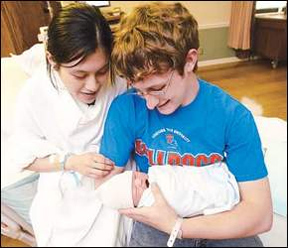
 |
Beverly Corbell
bcorbell@theadvertiser.com
Not many new dads put on swimming trunks for their baby's birth, but it was perfectly appropriate for Mark McKelvy, because he coached his wife, Josephine, through the birth of their new baby girl in a big tub of warm water.
Cordelia McKelvy was born Friday at 11:52 a.m. in a 5-foot diameter, 2-foot deep birthing pool at Women's & Children's Hospital. Mark got into the pool with his wife, holding her from behind in his lap, while Dr. Darrell Robinson knelt in front of the pool and nurse Bridget Manual assisted from the side.
Giving birth in water is natural, said Josephine McKelvy as she sat up in bed just two hours after giving birth. She said she learned about the birth method when she took a women's studies course at a college in Virginia.
"I couldn't find anything negative about it," she said. "Being in the water meant it had to be a natural childbirth, which I wanted. I hate needles and didn't want any drugs."
Some of their friends weren't so sure, Mark said, because they were worried the baby couldn't breathe and that it would be too painful for Josephine.
But there was no problem for little Cordelia, Manuel said, because newborns don't start breathing right away.
"When a baby is first born, they don't breathe oxygen because they're still using the placenta until the umbilical cord is cut," she said.
Robinson said this is the first underwater hospital birth in Lafayette.
"It is very natural and very soothing, in a calm and serene atmosphere, like birth originally was," Robinson said. "My hope is that we would open a water birth center at Women's & Children's, since we are pioneering this procedure here in Lafayette."
The cost of a water birth wasn't much more, said Mark McKelvy, because the only additional expense was the cost of renting the birthing pool for a few hundred dollars from Waterbirth International. They even got a discount because they're both students. Mark is majoring in computer science at the University of Lafayette, and Josephine will enroll this fall in sociology.
Water births are more prevalent in Europe, and most English hospitals are equipped for them, according to Pregnancy magazine. In an article on water births, the magazine claims that the water - which is at about 98 degrees - simulates the womb atmosphere and the baby doesn't experience such a temperature shock, making birth less traumatic. The article said the warm water helps the mother to relax.
Just in case something went wrong, Josephine had a shunt for an IV in her arm, but it wasn't needed.
"It was an easier birth than the norm," Robinson said, "and she didn't have any pain medication at all."
Originally published April 9, 2005